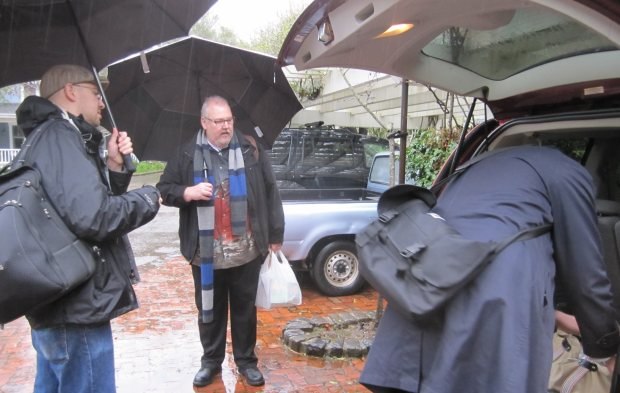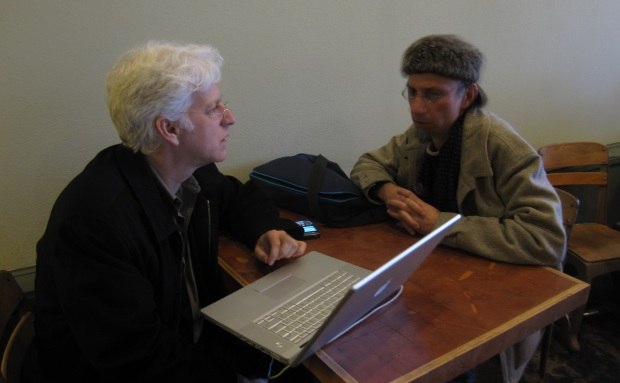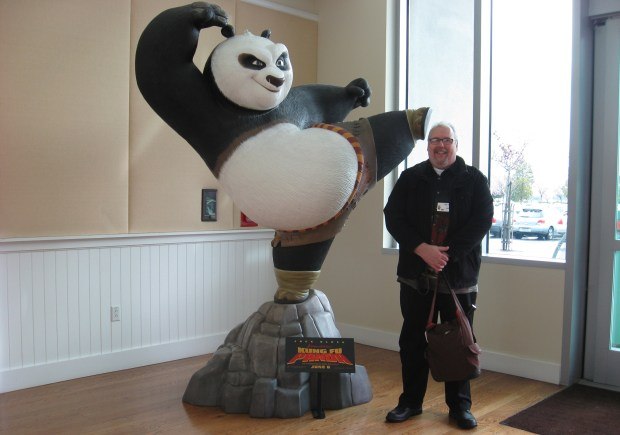Day 2 of our tour started exactly as Day 1 ended – everyone sleeping snugly in their rooms at the Skywalker Ranch Inn. Soon, we'd be off in the pouring ran in search of PDI...Dan Sarto continues the northern California leg of the 2011 AWN Oscar Tour with a trip to PDI/DreamWorks and a funky nameless Berkeley cafe.
Written by Dan Sarto
Day 2 of our tour started exactly as Day 1 ended – everyone sleeping snugly in their rooms at the Skywalker Ranch Inn. Each room at the Inn is named after and designed in the style of a noted celebrity – I was in the Frank Lloyd Wright room, Ron was in the Norman Rockwell room, others scattered within Orson Wells, Ella Fitzgerald, Lillian Gish rooms, to name a few. A fast breakfast of bagels, yogurt and sugary, creamy, caffeiny Starbucks’ coffee drinks, followed by a mad dash to load the car without getting soaked and we were off in the pouring rain towards Redwood City and PDI/DreamWorks. Our stay at the Inn was way too short, but I can honestly say it was truly cool with a capital K.
The drive to PDI/DreamWorks was 2 hours of the hardest rain I’ve ever been in – the noise of the water hitting the car was so loud you could barely converse with the person beside you. Every so often, we’d drive underneath an overpass or through a tunnel – the constant roar came to an instant halt, an eerie quiet enveloped the car for a few seconds, then the roar returned as quickly as it had vanished.
The GPS brought us close to our destination, but not quite close enough – after a brief roadside stop to recalibrate and turn the car around, followed by another short freeway jaunt, we finally arrived at the studio. Maybe it’s just me, but so far this trip, I’ll take a Thomas Guide over that digital Lewis & Clark any day.
PDI/DreamWorks sits in a rather non-descript modern office building next to one of Cargill’s salt manufacturing facilities, long flat channels fed by sea tides, then blocked off to initiate evaporation and eventual collection. We all got the “willies” thinking about SF Bay-produced sea salt sprinkled all over our food. Ah, Fleur de Alcatraz.
At PDI, we were greeted warmly by Lindsay Caplan, who shepherded us into the commissary for a much-appreciated lunch. The food was excellent by the way. Teddy had driven separately and joined us for our meal. We jokingly speculated about how revealing our tour would (or wouldn’t) be with a dreaded rival Pixarian in tow. However, the current industry trend of vagabond staff and casual movement between studios makes that point rather moot – considering how many people at these studios have no idea what goes on in the adjacent cubicle let alone on rival company productions shows how people do understand the seriousness of keeping quiet about what they’re working on. I’ve never been one to question corporate secrecy – my mom still thinks I work in the tool department at Sears.
We spent lunch with Jason Schleifer and Rex Grignon, the two heads of character animation, as well as Maciek Gliwa, a Polish animator who did extensive work on The Gruffalo before going to work for DreamWorks. Rex is following up his work on Madagascar 1 and 2 with the upcoming third film in the series, while Jason is working on a yet to be announced feature production. I met Jason many years ago at an event in London, fresh from animating Gollum for Weta in New Zealand. It’s always great to see him and I consider his work on bringing Gollum to life some of the most extraordinary animation I’ve ever seen, before or since.
From lunch, we kicked off the studio screening. Ron again gave an eloquent introduction as Geefwee, Teddy, Max and Jakob joined him at the front of the theatre for a few minutes of conversation with the assembled audience. The screening began so we made a quick exit into the hallway where we were introduced by Lindsay to Marty Sixkiller, who took us on a brief studio tour. Marty Sixkiller has been with PDI since 1995 and knows both the history and intricacy of their production system in great detail. He walked us through portions of both production floors, detailing for us their well-oiled pipeline, using How to Train Your Dragon as his primary example. Of course, we weren’t able to take any photographs and unlike our tours of DreamWorks in Glendale, we weren’t able to look at any artwork from upcoming productions. No venturing off the wooden floors onto carpeted territory for fear of an attorney’s phone call. I wonder if we have Teddy to blame for that. Marty did share, for example, that one area we visited was kept completely devoid of direct light – overhead and window lights were masked, allowing technical staff to view final color without compromise. After the tour, we had a tasty beverage back in the commissary and waited for the screening to end.
A number of people asked questions. First, Teddy was asked about his film’s sound design. He talked about the entertaining effects of cartoon sounds but that they found those didn’t work right for Day & Night. Then he figured that the use of real life sounds that “matched” the behavior of the characters would add a dimension of humor. Jakob and Max were asked about their choices for character design. They explained that since their film is based on a children’s book much beloved in the UK and Germany, they took great care to keep the designs in line with the source materials. Initially, they did a 1 minute animation test, which helped them decide how to handle the animation. They settled on physical sets with cg characters, in part because of time and budget. However, they wanted a more “tactile” feel to the characters so they would blend well with the backgrounds, which can be seen in the final character design. They didn’t, however, intend to make the characters look like they were animated with stop-motion.
Teddy then was asked about the genesis of Day & Night. He explained how he’d done a lot of end titles at Pixar, including The Incredibles, and was asked to come up with a short design in a similar graphic style. He couldn’t believe they would do any “film” with a graphic style, so initially he ignored them. Eventually they broke him down. He knew they were moving towards 3-D and figured it might be a good opportunity to do a blend of something graphic and in 3-D. This might be something they’d want to try. The initial idea involved looking through a keyhole – he put a pair of eyeballs on a keyhole and had it looking inside its own body. He kept adding to that idea, adding a pair of legs and eventually he came up with the idea for the two characters. When he had the first character looking at the horizon, the break between the sky and the land made him look like he had green pants, which then led to designing two different characters at different times of the day, wearing two different colored pants. They made a 3-D test and showed it to John Lasseter as an idea for some simple, fun animation that had no attachment to live action. John really liked the idea and so full production soon began.
Teddy went on to say that the film took 9 months to make, from storyboard to finished sound. He got a big laugh when he told the audience that his film is the only one at Pixar to ever come in ahead of schedule. He was quite happy about that because he didn’t want anyone to get mad at him as the films are so expensive to produce.
Geefwee was asked how he narrowed down his final story. He described how it was a difficult task to whittle down the film, to boil it down to a digestible chunk that wasn’t just a sound bite. He worked hard to make his film say what he wanted to say yet still be accessible and enjoyable to an audience. Then he shared that his plan has always been to make Let’s Pollute the first of a 3-part film trilogy – he’d like to follow this film with Peace is for Sissies and then Try Ignorance. Since he financed his first film completely on his own, outside funding is needed if he’s ever going to get the other 2 films made.
The Q&A ended and we headed for the car and cross-bay trip to our evening screening at Tippett Studios. With a bit of time to kill and much email to deal with, we sought out a café near Berkeley recommended by Geefwee. Though he knew the name and rough location, he wasn’t sure exactly how to get there, so we fired up the reliable GPS, ensuring we would miss our destination completely and burn up precious time just driving around. I can’t even remember the café’s name, but it was warm, dry and properly staffed by brightly-garbed expertly pierced youth. Though the vegan scones in the display case looked like they’d fallen to earth during a Cretaceous-era volcanic eruption, the orange Pellegrino drink was quite tasty. The short schedule break actually gave me time for leisurely talk with Geefwee, Jakob and Max individually, which I hope to have written up later this week. It’s always interesting to learn more about a director’s trajectory through the industry and their stories were very entertaining. We eventually finished our refreshments and headed off to Tippett. More on the wonders to be found in the hallowed halls of Tippett Studios in my next post.
Dan Sarto is Publisher and Editor-in-Chief of Animation World Network.















